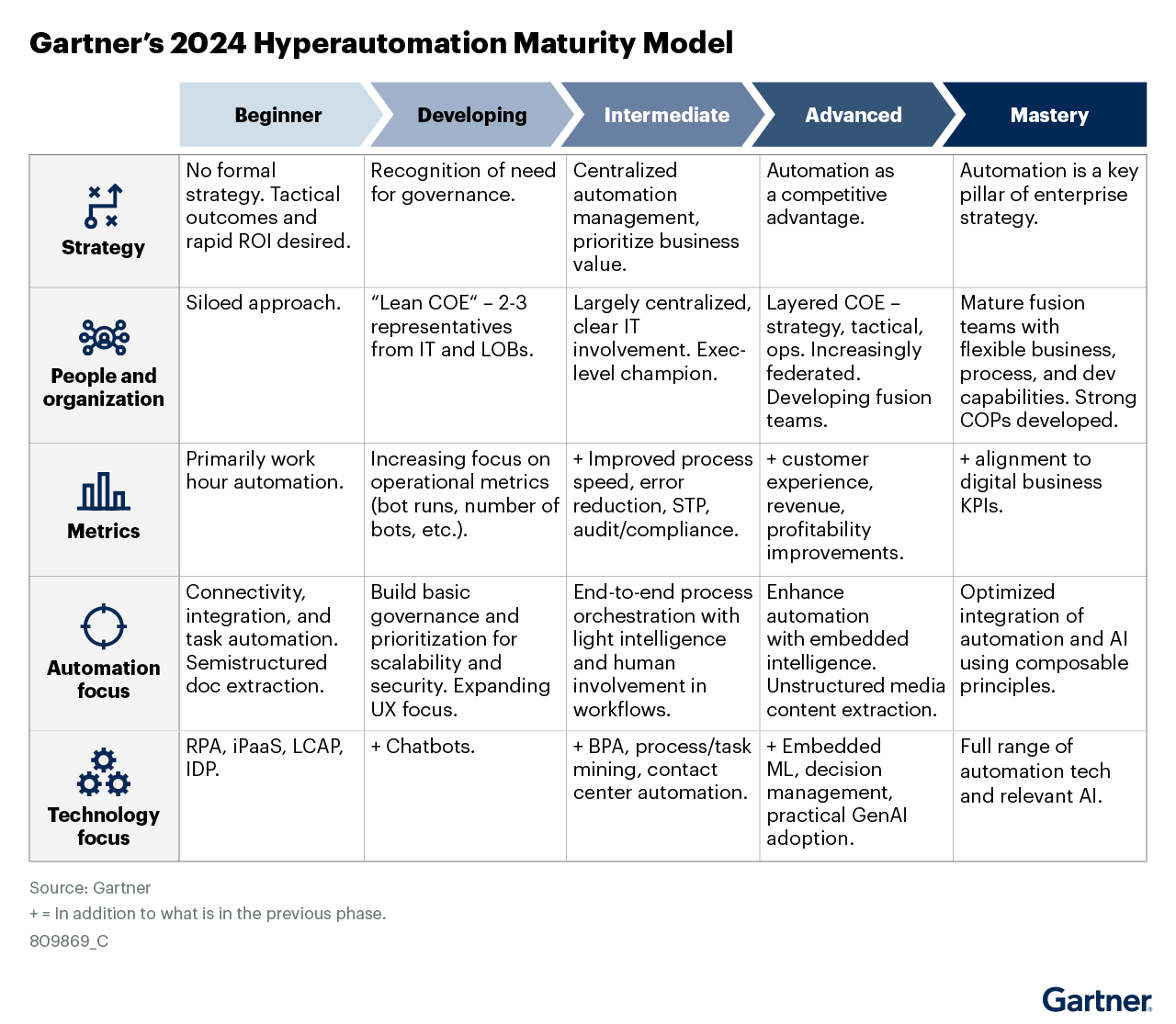How Automated Are Business Processes? Let’s Find Out with the Hyperautomation Maturity Model

One of the primary goals of enterprise applications is tasks and process automation within a company. For this reason, one of the main responsibilities of Application Managers is the modernization of systems through the continuous search for the most advanced technologies, which eliminate as many manual activities as possible to improve efficiency and reduce errors.
As Gartner®[1] “Automation strategies have changed dramatically over the last five years. They now need to include the convergence of technologies like robotic process automation (RPA), intelligent document processing (IDP), business process automation (BPA), process mining, low-code application platform (LCAP), integration platform as a service (iPaaS) and test automation."
With the continuous advancement of technology, it is not easy for Application Managers to understand the level of automation in their company and how to improve it. For this reason, Gartner provides a model, the Hyperautomation Maturity Model[2] (fig.1), che secondo noi costituisce una chiara guida di riferimento per capire lo stato della propria azienda (o della propria divisione), which we believe serves as a clear reference guide to assess the state of a company (or division) and offers practical advice for advancing along the maturity path.

Analyzing Automation Maturity and Tips for Advancement
There are five key aspects: strategy, organization, metrics, automation and technology focus. The model identifies five levels of maturity: beginner where according to Gartner, “Organizations in the beginner phase are usually under a year into their automation journey”. “Organizations in the developing phase employ basic automation governance, and more integrated business and IT initiatives.” At the intermediate level, “Organizations in the intermediate phase have developed a strong governance and development foundation”. “Organizations in the Advanced phase view automation as a key competitive differentiator that provides agility, scaling and efficiency.” Finally, Gartner says that the “organization in the mastery phase view automation as a key pillar of their enterprise strategy.”
Moving from the initial levels requires creating an evaluation framework, communicating the value of automation, and strengthening collaboration between IT and business. At intermediate levels, the focus should be on process optimization, a clear definition of responsibilities, and enterprise-wide automation. For the advanced stages, automation must align with strategic objectives, integrate artificial intelligence, and develop a regulated citizen development program. Finally, at the highest level of maturity, it is essential to create synergies between automation and AI, leverage unstructured data, and collaborate with key vendors to continuously innovate.
Focus on Technologies: Low-Code Application Platform
The Maturity Model highlights how, in the early stages of enterprise automation, the adoption of technologies such as RPA and Low-Code (LCAP – Low-Code Application Platform) is crucial.
Based on our experience in innovation and automation, it is essential to adopt Low-Code platforms from the very beginning of enterprise automation initiatives, as they support collaboration between Business and IT and are easily integrable with other technologies or external systems.
Specifically, in the case of WebRatio Platform, the platform is already ready to accompany companies through the subsequent stages of the maturity journey, as it also includes Business Process Management and Automation tools, enabling the automation of even the most complex processes and providing more stable centralized governance.
But that’s not all—WebRatio Platform is also ready for the more advanced stages because it allows the integration of the latest digital technologies into the most complex enterprise applications, automating processes that are still manual, thanks to artificial intelligence and the ability to involve citizen developers.
Watch the demo of BPM software development with WebRatio Platform >
Sources
[1] Gartner®, Optimize Automation Using the Hyperautomation Maturity Model, by Arthur Villa, Sachin Joshi, Cathy Tornbohm, 10 April 2024. GARTNER is a registered trademark and service mark of Gartner, Inc. and/or its affiliates in the U.S. and internationally and is used herein with permission. All rights reserved.
[2] https://www.gartner.com/document-reader/document/5346463
Latest Stories
CIO priority for 2026: boosting productivity, including Low-Code
Customised AI in 1 Month with Low-Code: AI Mind by OriginalSkills
WebRatio Platform 9.3.0: more autonomy, more productivity, more control – and a new look for your apps
Tag
AllArtificial Intelligence - AI
BPA Development
BPM Software
Customer
Digital Transformation
Distribution & Retail
Energy & Utilities
Enterprise Applications
Finance & Insurance
IoT
LinkedIn Live
Low-code
Manufacturing
Mobile Development
Modernization
Partner
Shadow IT
Travel & Transportation
Web Development
WebRatio Platform